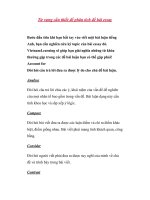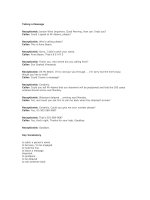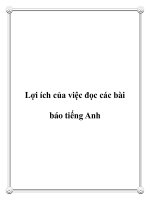Phân tích 1 bài báo tiếng anh_ analysis a newspaper
Bạn đang xem bản rút gọn của tài liệu. Xem và tải ngay bản đầy đủ của tài liệu tại đây (331.61 KB, 9 trang )
ASSIGNMENT 1:
CRITICALLY EVALUATING NEWS REPORT
Version 1
Group 11
1. Trần Vũ Hà Ngọc Anh
2. Nguyễn Thị Trâm Anh
3. Đỗ Thị Thu Hoài
4. Lê Lam Thủy
I.
News report’s description
Title: Bill Gates brandishes poo to showcase reinvented toilet tech
Date of publish: 6 November 2018
Catelogy: Technology of BBC newspaper
Article:
Bill Gates brandishes poo to showcase reinvented
toilet tech
6 November 2018
Billionaire philanthropist and Microsoft founder Bill Gates had his hands full on-stage in Beijing
on Tuesday, showing a jar of human faeces.
The stunt was part of his speech at the Reinvented Toilet Expo event - a showcase for new toilet
technologies.
The Bill & Melinda Gates Foundation has spent more than $200m on researching the field across the last
seven years.
Twenty cutting-edge sanitation products were on display, intended to destroy harmful bacteria and
prevent disease.
"I have to say, a decade ago I never imagined that I'd know so much about poop," Mr Gates joked at the
conference. "And I definitely never thought that Melinda would have to tell me to stop talking about toilets
and faecal sludge at the dinner table."
The entrepreneur was helping to launch the three-day event in China - where leader Xi Jinping has made
a so-called "toilet revolution" across the country a policy priority.
The showcased products aim to revolutionise sanitation technology by operating off-grid to separate
liquid and solid waste and remove harmful by-products.
"It's no longer a question of if we can reinvent the toilet and other sanitation systems," he said. "It's a
question of how quickly this new category of off-grid solutions will scale."
The entrepreneur described the inventions on display as the "most significant advances in sanitation in
nearly 200 years".
Deadly disease
The technology giant pointed out the jar of faeces beside him could contain "as many as 200 trillion
rotavirus... 20 billion Shigella bacteria, and 100,000 parasitic worm eggs".
Mr Gates' foundation - which he has donated billions to - operates in 130 countries
According to the World Health Organisation (WHO), 2.3 billion people around the world still don't have
access to basic sanitation facilities.
This can cause diseases like cholera, diarrhoea and dysentery which kill hundreds of thousands of
people every year.
Speaking to the BBC, Mr Gates discussed the inequalities in sanitation access.
"In rich countries we have sewers that take clean water in, flush some of the dirty water out, in almost all
cases there's a treatment plant," he said.
"As we have these newer cities with lots of less wealthy people in them, those sewers have not been built
and in fact, it's not likely they ever will be, so the question is, could you do it? Could you process human
waste without that sewer system?"
The foundation has said they hope the reinvented toilet will first roll out in buildings like schools and
apartment buildings, before costs gradually decline and they become affordable in households.
"You're only going to pay hundreds of dollars for a toilet - if it's really fantastic maybe $500," Mr Gates
told the BBC.
"You're saving all the costs of the waters, the processing products, but we have to bring it down by
almost a factor of 10 from what the models are like - but that's not atypical for new product markets."
On his trip, Mr Gates also appeared at the First China International Import Expo in Shanghai, at a time of
tension between the US and China.
The world's two largest economies have been engaged in a tit-for-tat trade war over tariffs for much of
the year.
- Source: />II. Analyzing
Content and
detail
1. What was the headline for the story?
-The headline is a particularly rich source of information about the field
of cultural references. This is because titles 'stand-alone' without
explanation or definition; they depend on the reader recognizing
instantly the field, allusions, issues, cultural references necessary to
identify the content of the articles.
- The headline of this article is “Bill Gates brandishes poo to showcase
reinvented toilet tech”
2. Effectiveness of the headline
- When reading the title of this article "Bill Gates brandishes poo to
showcase reinvented toilet tech," we can easily see the information the
author wants to transmit. That is Bill Gates has launched a new toilet
technology - the main content of the article. The title summarizes the
main content of the article, so readers know clearly what they are going
to read. However, the title is also attracted by the phrase "Bill Gates
brandishes poo" which arouses the curiosity of the reader to find out
why "Bill Gates brandishes poo".
- The aim of the headline is to grab readers’ attention. Therefore, any
‘unneccessary’ words are often left out.
- Articles: Bill Gates brandishes poo to showcase the reinvented toilet
tech.
- The headline uses present simple tense to say that the story is
happening now rather than in the very recent past.
- The headline also use very short words to make an impact. This
headline could also read “ Bill Gates uses poo to introduce sanitary
technology is reinvented”; however, this does not have the same impact
as the short headline above.
- This headline also is ambiguous making the reader look at the article.
“Bill Gates brandishes poo” is ambiguous because this makes the
readers confused and curious. Readers do not understand why Bill Gates
brandishes poo to introduce the new technology.
3. Briefly describe the factual content of the story related to the
lead: 5W’s and the H
•
Who : Bill Gates
•
What: showcase reinvented toilet tech
•
When: on Tueday (6/11/2018)
•
Where: Beijing, China.
4. Evaluating the end of article
- One drawback of this article is that the ending does not summarize the
main points of the article.
5. The facts in this newspaper are supposed to be arranged from
most to least.
- The article presents information about the event Bill Gates introduced
toilet technology which destroys harmful bacteria and prevents disease.
- The author mentions the serious epidemics caused by harmful bacteria,
access to basic sanitation facilities of rich and poor countries. This
information is just arguments to demonstrate the necessity and
practicality of Bill Gates' new product.
6. The accuracy of the facts
- The report posts a lot of photos of Bill Gates giving a speech in the
conference. Moreover, we can see the screen showing the structure of
Bill Gate’s invention behind him in some photos. These sources are
really reliable. In addition, all of the quotations included in the report
belong to Bill Gate who is directly involved in the topic
7. The use of quotations
- The report is about the new invention of the Bill Gate’s company.
Therefore, the use of quotations which are from Bill Gate helps to
increase the accuracy of the content.
- The topic is quite funny to the readers. As the result, the quotation of
Bill Gate’s funny jokes makes the report more interesting and closer to
the reader
Linguistic
features
8. Thing missed out
- The only thing missed out in the report is the name of the author
9. Analyzing features of the report
Paragraph structure
- This newspaper report is split into small units. There is a subheading
in the left to give brief information of each unit.
- The article is broken up into short paragraphs; each one has a few
lines. With short one, there are some resting-places for the eyes. It is
easier for readers to read than writing a long paragraph and readers
would concentrate more.
- Moreover, this article has variation in type-size used. For example, the
first paragraph is bold to attach attention. The subheading in the next
portion is in the different font, larger size.
- Besides, we should focus on the line of space of the text. The space
between the headlines and story and the space between “CHAPEAU”
and the story is quite large, which helps readers read easily, especially
skim reading.
2. Complexity of the lexical choices: technical terms, interesting and
varied words, figurative language.
Technical terms:
- This article uses lots of sanitation technology terms: toilet revolution;
reinvented toilet technology; sanitation systems; off-grid; liquid and
solid waste; harmful by-products.
- Terms about the disease like cholera (bệnh tả), diarrhea (bệnh ỉa
chảy), dysentery (bệnh lị), Shigella bacteria (khuẩn Shigella), rotavirus
(virus gây viêm dạ dày)
Figuarative language:
- Alliteration: policy priority; sanitation systems
- Idiom: tit-for-tat( ăn miếng trả miếng)
3. Sentence type and sentence structure
Sentence type
- Sentence type is largely statement. There are some questions which do
not expect the answer; these questions have a role to keep the pace of
the article from dragging.
- This report uses indirect and direct speech sentences. Some verbs that
this article used such as: described, pointed, said, appeared
Sentence structure
- This report includes simple sentences, compound sentences and
complex sentences.
+ The clauses in a compound sentence are joined by coordinating
conjunctions such as and, but… for example:
You're saving all the costs of the waters, the processing products,
but we have to bring it down
+ Complex sentences:
* Conditional clause: It's no longer a question of if we can
reinvent the toilet and other sanitation systems
* Relative clause: This can cause diseases like cholera, diarrhea
and dysentery which kill hundreds of thousands of people every
year.
- Major type is simple sentence; some complex sentences would be
distributed among shorter sentences => readability and comprehension.
- Complex sentences tend to be avoided at the beginning of the articles
4. Cohesive devices
- Cohesive devices, sometimes called linking words, linkers, connectors,
discourse markers or transitional words and these are words or phrases
that show the relationship between paragraphs or sections of
a text or speech.
- “and”, “but” are cohesive devices used in this report:
+ The showcased products aim to revolutionize sanitation technology
by operating off-grid to separate liquid and solid waste and remove
harmful by-products =>”and “is used to add information and to connect
two verb phrases within one sentence
+ "You're saving all the costs of the waters, the processing products, but
we have to bring it down by almost a factor of 10 from what the models
are like - but that's not atypical for new product markets." => “but” is
used to indicate adversative meaning relationship.
Tone
Accompanyin
g photo
- There is no bias.
- The language of the report is neutral. We cannot find any exclamations
in the report. The content is just about describing the new invention and
Bill Gate’s speech without adding any emotion or private opinion of the
author.
Chosen photos help enhance the story. They grab the reader’s attention
better than a block of text and lead to more people reading the article.
III. Strengths and weaknesses
1. Strengths
- The title is catchy; it makes readers pay more attention to the article.
- The article is informative. It splits into small paragraphs to read easier as well as
do not feel boring.
2. Weaknesses
- The ending of article lacks summarising, so readers find difficult to sum up of all
information.
- The illustration of the article is not diverse. If the article has more images and
videos, it will more attractive.
References
Source: />









